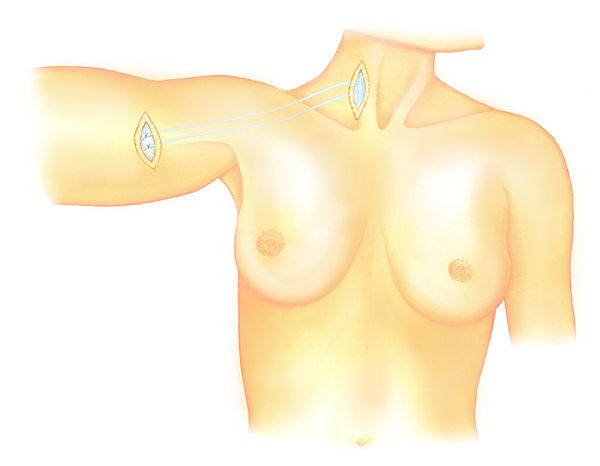Lymphatic Vessel Grafting
Thanks to advanced microsurgical method, developed by Prof. Baumeister in 1980, lypmh vessels can be used as grafts to bypass obstructed lymphatic pathways. Studies shown that the method is very effective, even more than 10 years after the surgery.
In vascular surgery bypassing an interruption of the vessels is a commonly used successful practice.
With the help of advanced microsurgery the same principle is applied in the case of a locally interrupted or compromised lymphatic vascular system.
Arm edemas after axillary dissection with removal of lymph nodes often in combination with radiation, unilateral edemas of the lower extremities after removal of lymphnodes in the course of treating malignant tumors and locally interruptions of lymphatic vessels after surgeries or trauma are candidates for lymphatic reconstructions.
Also the rare primary lymph edema with a locally compromised lymphatic system may be treated.
Technique of Lymphatic Vessel Grafting
Lymphatic vessels are not simply tubes, they actively transport lymph fluid with the help of muscles within the tiny wall and valves within a low pressure system. Therefore they are the best choice to replace the original lymphatic transport system.
An appropriate donor site is the so called ventro-medial bundle at the inner aspect of the thigh which contains up to 16 lymphatic vessels. Some of them can be used as grafts (Figure A).

(A) Lymphatic vessel grafts harvesting
In the case of an arm edema, the lymphatic grafts are interposed within the subcuataneous tissues between the upper arm and the neck region, bypassing the damaged axilla. At the upper arm and the neck as well, direct microsurgical anastomoses are performed between the graft and the lymphatic vessels creating a direct reconstruction of the lymphatic system (Figure B).

(B) Lymphatic grafting in arm edema
In the case of an unilateral edema of the lower extremity the lymphatic graft is transposed via the symphysis to the affected leg and anastomosed with ascending lymphatic vessels. Than the lymph fluid can flow via the grafts to healthy side (Figure C).

(C) Lymphatic grafting in leg edema
The method of autologous lymphatic grafting to treat a locally compromised lymphatic vascular system was developed experimentally within the Institute for Experimental Surgery and first perfomed in 1980 in the Department of Surgery Grosshadern the Ludwig Maximilians University of Munich by Prof. Baumeister.
The follow up studies showed long term reductions of the volumes up to a normalization.
Independent investigators of the Department of Nuclear Medicine measured a significant improvement of the lymphatic flow up to a normalization.
Long term patent lymphatic autografts where shown by investigators of the Department of Radiology after more than 10 years after grafting.
ฺBibliography
-
Dahlbäck, Baumeister R, Aberg M, Arnljots B, Frost Arner L, Brorson H (2021)
Long term outcome of lymph vessel transplantation after chronic lymphorrhea, Case Reports in Plastic Surgery and Hand Surgery 8: 169-1754
-
Baumeister RGH, Frick A (2003) Die mikrochirurgische Lymphgefäßtransplantation, Handchir Mikrochir Plast Chir 35:202-209
-
Baumeister RGH, Siuda S (1990) Treatment of lymphedema by microsurgical lymphatic grafting: what is proved?, Plastic Reconstr Surg 85:64-74
-
Baumeister RGH, Seifert J, Wiebecke B Hahn D (1981) Experimental basis and first application of clinical lymph vessel transplantation of secondary lymphedema, World J Surg 5: 401-407